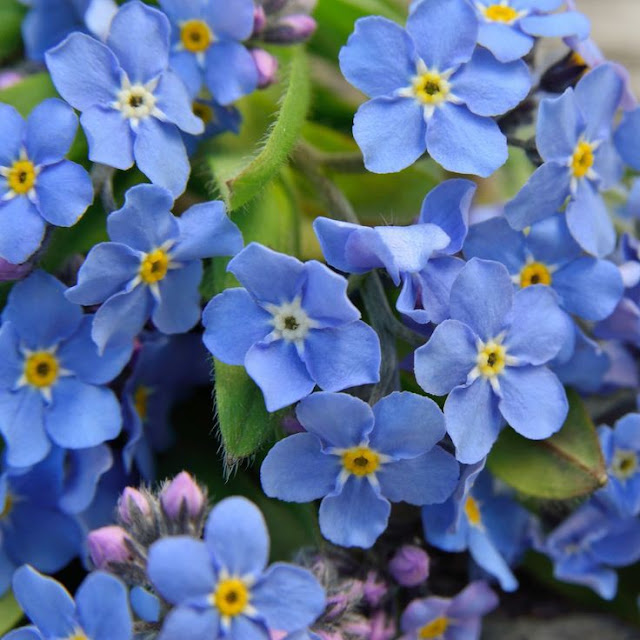Forget-Me-Nots: A Comprehensive Guide to Planting and Maintaining
The Enchanting World of Forget-Me-Nots: Varieties and Environmental Benefits
Forget-me-nots (genus Myosotis) are a captivating and diverse group of flowering plants known for their charming blue petals and historical significance. The name "Forget-me-not" comes from the Middle High German word "vergessen mein nicht" and carries a poignant message of remembrance and enduring affection. These petite flowers, typically characterized by their vivid blue hue and yellow centers, have long held a place in gardens and hearts worldwide. In this article, we will explore the various species of forget-me-nots, their distinct characteristics, and the positive impact they have on the environment.
Varieties of Forget-Me-Nots
Forget-me-nots belong to the Boraginaceae family and include a wide range of species. Each species has unique attributes, adapting to various climates and growing conditions.
1. Myosotis scorpioides (True Forget-Me-Not)
Commonly referred to as the "True Forget-Me-Not" or "Water Forget-Me-Not," Myosotis scorpioides is a perennial plant that thrives in wet and marshy environments. This species features bright blue flowers with yellow centers, blooming from late spring to early summer. Its natural habitat includes stream banks and wetlands, making it a perfect choice for gardens with water features.
2. Myosotis sylvatica (Wood Forget-Me-Not)
Myosotis sylvatica, known as the "Wood Forget-Me-Not," is a biennial or short-lived perennial that prefers shaded areas and woodland environments. This species has similar blue flowers with yellow centers and blooms in early spring. The Wood Forget-Me-Not is well-suited for woodland gardens and areas with partial shade, adding a splash of color to the undergrowth.
3. Myosotis arvensis (Field Forget-Me-Not)
The "Field Forget-Me-Not," or Myosotis arvensis, is an annual or biennial plant found in meadows, fields, and other open spaces. It is more tolerant of dry conditions compared to other species and has a more delicate appearance. The flowers of this species are smaller, with a pale blue hue, and bloom throughout the growing season.
4. Myosotis alpestris (Alpine Forget-Me-Not)
As the name suggests, the "Alpine Forget-Me-Not" (Myosotis alpestris) is native to alpine and subalpine regions. This perennial plant features intense blue flowers and is often used in rock gardens and alpine landscapes. It blooms in late spring to early summer and is highly valued for its ability to thrive in high-altitude environments.
5. Myosotis laxa (Small-Flowered Forget-Me-Not)
The "Small-Flowered Forget-Me-Not" or Myosotis laxa is a versatile species that can grow in both wet and dry conditions. It is commonly found along riverbanks, in marshes, and in moist woodlands. This species is characterized by its smaller, delicate blue flowers and long blooming period, making it a popular choice for naturalistic and wildflower gardens.
Environmental Benefits of Forget-Me-Nots
Forget-me-nots are not only aesthetically pleasing but also offer several environmental benefits. These plants play a crucial role in supporting biodiversity, improving soil health, and contributing to sustainable gardening practices.
1. Supporting Pollinators
Forget-me-nots are excellent attractors of pollinators, including bees, butterflies, and other beneficial insects. The vibrant blue flowers provide a reliable source of nectar and pollen, which are essential for the survival of these pollinators. By planting forget-me-nots in gardens and landscapes, gardeners can help support local pollinator populations, which are vital for the pollination of many crops and wild plants.
2. Soil Health and Erosion Control
The dense foliage of forget-me-nots helps to protect the soil from erosion by reducing the impact of rain and wind. This is particularly beneficial in areas prone to soil erosion, such as riverbanks and slopes. Additionally, the roots of forget-me-nots help to stabilize the soil, preventing it from being washed away. This contributes to maintaining soil health and preventing the loss of valuable topsoil.
3. Natural Weed Suppression
Forget-me-nots can serve as an effective ground cover, helping to suppress the growth of unwanted weeds. Their dense growth habit and ability to spread quickly create a natural barrier that inhibits the establishment of invasive weed species. This reduces the need for chemical herbicides, promoting a more environmentally friendly approach to weed management.
4. Enhancing Biodiversity
By incorporating a variety of forget-me-not species into gardens and landscapes, gardeners can enhance biodiversity and create habitats for a range of organisms. The flowers provide food and shelter for pollinators, while the foliage offers habitat for other insects and small wildlife. This increased biodiversity contributes to the overall health and resilience of ecosystems.
5. Aesthetic and Psychological Benefits
The presence of forget-me-nots in gardens and natural landscapes offers aesthetic and psychological benefits. The vibrant blue flowers create visually appealing displays that can improve mental well-being and reduce stress. Gardens with diverse plantings, including forget-me-nots, provide spaces for relaxation, contemplation, and connection with nature.
Conclusion
Forget-me-nots are more than just beautiful flowers; they are essential components of healthy ecosystems and sustainable gardening practices. With a wide range of species adapted to various environments, forget-me-nots can be incorporated into many different garden settings, from water gardens to woodland landscapes. By supporting pollinators, improving soil health, suppressing weeds, enhancing biodiversity, and providing aesthetic and psychological benefits, forget-me-nots play a significant role in promoting environmental sustainability. As gardeners and nature enthusiasts, embracing these charming blue flowers can help us create more vibrant and resilient landscapes for future generations.











Comments
Post a Comment
If you have any doubt, please let me know, thanks for your love and response